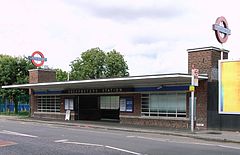- Cockfosters tube station
-
Cockfosters 

Location of Cockfosters in Greater LondonLocation Cockfosters Local authority London Borough of Enfield Managed by London Underground Number of platforms 4 (facing 3 tracks) Fare zone 5 London Underground annual entry and exit 2008  1.760 million[1]
1.760 million[1]2009  1.675 million[1]
1.675 million[1]2010  1.670 million[1]
1.670 million[1]1933 Opened (Piccadilly Line) List of stations Underground · National Rail Coordinates: 51°39′06″N 0°08′56″W / 51.6516°N 0.1488°W
Cockfosters is a London Underground station on the Piccadilly Line for which it is the northern terminus. The station is located on Cockfosters Road (A111) approximately 9 miles from central London and serves Cockfosters in the London Borough of Barnet although it is actually located a short distance across the borough boundary in the neighbouring London Borough of Enfield. The station is in Travelcard Zone 5 and the next station south-east is Oakwood.
Contents
History
The station opened on 31 July 1933, the last of the stations on the extension of the line from Finsbury Park to do so and four months after Oakwood station (then called Enfield West) opened. Prior to its opening, "Trent Park" and "Cock Fosters" (an early spelling of the area's name) were suggested as alternative station names. The original site hoarding displayed the name as a single word.
The station was designed by Charles Holden in a modern European style using brick, glass and reinforced concrete.[2] Compared with the other new stations Holden designed for the extension, Cockfosters' street buildings are modest in scale, lacking the mass of Oakwood or Arnos Grove or the avant-garde flourish of Southgate. Holden's early design sketches show the station with two towers.[3] The most striking feature of the station is the tall concrete and glass trainshed roof and platform canopies which are supported by portal frames of narrow blade-like concrete columns and beams rising from the platforms and spanning across the tracks. The trainshed roof constructed at Uxbridge in 1937-38 was built to a similar design. Cockfosters station is a Grade II listed building.
The station has three tracks with platforms number 1 to 4; the centre track being served from both sides by platforms 2 and 3. This is an example of the so-called Spanish solution. Most northbound Piccadilly trains terminate here although some terminate at Oakwood or Arnos Grove, particularly in peak hours or in the evenings. Cockfosters depot is located between Oakwood and Cockfosters and trains can access or leave it from either direction.
2006/7 Refurbishment
In late 2006, Cockfosters Station began an intensive refurbishment programme to bring it up to standards with all other stations on the Tube network, as part of the Tube's £10billion upgrade scheme. The aim was to modernise the area, but still maintain the charm of the old building.
The plans included:
- Resurfacing the staircase on the east and west entrances to make them more user-friendly for those with sight problems.
- Painting of the original wooden seating areas on the east side entrance as well as minor restoration.
- Fitting of "Emergency Signal" notices on either side of the station to alert passengers of closed entrances.
- Installation of electronic platform train schedule systems, which inform passengers of immediate tube departures in addition to the destination. This aims to reduce confusion as to which of the three tube platforms' trains will be leaving first, and when.
- Installation of full CCTV operation both above and below the station grounds to improve security.
- Installation of London Underground Passenger Information Systems, both above and below ground
The above improvements were made to the station as well as a number of more minor additions to improve the building and bring it up to modern-day usage standards.
The improvements were completed by May 2007.
Places Nearby
- Trent Park
- East Barnet
- Enfield Chase
- Cat Hill Campus Middlesex University
- The "London LOOP" walk uses the station's foot tunnel to cross Cockfosters Road.
In popular culture
Cockfosters tube station features prominently in the novel While England Sleeps by American author David Leavitt. One of the novel's protagonists is writing a book entitled The Train to Cockfosters.[4]
Gallery
See also
Local Connections
Cockfosters station is the terminus for the following Transport for London bus routes:
- 299 to/from Muswell Hill Broadway via Southgate tube station and Bounds Green tube station
- 384 to/from Barnet, Quinta Drive via New Barnet railway station and High Barnet tube station
- N91, night bus route running nightly to/from Trafalgar Square, largely following the day route taken by the Piccadilly Line
Also calling both northbound and southbound at Cockfosters station is TfL route 298 (Arnos Grove tube station - Potters Bar, Cranborne Road) via Southgate tube station, Cockfosters tube station, and Cockfosters Road (for Hadley Wood).
References
- ^ a b c "Customer metrics: entries and exits". London Underground performance update. Transport for London. 2003-2010. http://www.tfl.gov.uk/tfl/corporate/modesoftransport/tube/performance/default.asp?onload=entryexit. Retrieved 8 May 2011.
- ^ Paulsen, Ingvild (14 June 2003). "Undergrunnsarkitektur" (in Norwegian). Dagens Næringsliv: p. 28.
- ^ "Underground Journeys: Cockfosters". Royal Institute of British Architects. http://www.architecture.com/LibraryDrawingsAndPhotographs/Exhibitionsandloans/VARIBAArchitecturePartnershipexhibitions/UndergroundJourneys/ChangingthefaceofLondonUnderground/Cockfosters.aspx. Retrieved 20 February 2011.
- ^ Max, D.T. (3 October 1993). Los Angeles Times. http://articles.latimes.com/1993-10-03/books/bk-41528_1_leavitt-england-sleeps?pg=2.
External links
- London Transport Museum Photographic Archive
- Early sketch design by Charles Holden, 1931, Royal Institute of British Architects
Preceding station  London Underground
London UndergroundFollowing station Piccadilly line Terminus Categories:- Rail transport stations in London fare zone 5
- Piccadilly Line stations
- Tube stations in Enfield
- Grade II listed buildings in London
- Grade II listed railway stations
- Railway stations opened in 1933
- Charles Holden buildings
Wikimedia Foundation. 2010.











